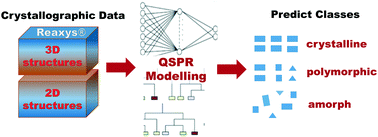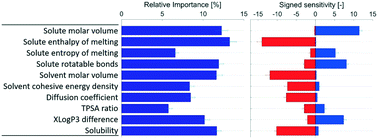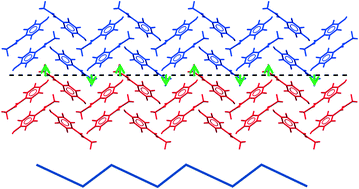Themed collection Editor’s Collection: Computer aided solid form design

A random forest model for predicting crystal packing of olanzapine solvates
A random forest (RF) classification model obtained from physicochemical properties of solvents and crystal structures of olanzapine has for the first time enabled the prediction of 3-D crystal packings of solvates. A novel solvate was obtained by targeted crystallization from the solvent identified by RF model.

CrystEngComm, 2018,20, 3947-3950
https://doi.org/10.1039/C8CE00261D
Machine learning methods to predict the crystallization propensity of small organic molecules
Machine learning algorithms were explored for the prediction of the crystallization propensity based on molecular descriptors and fingerprints generated from 2D chemical structures and 3D chemical structures optimized with empirical methods.

CrystEngComm, 2020,22, 2817-2826
https://doi.org/10.1039/D0CE00070A
Cocrystal design by network-based link prediction
Cocrystals are predicted using a network of coformers extracted from the CSD.

CrystEngComm, 2019,21, 6875-6885
https://doi.org/10.1039/C9CE01110B
The interplay among molecular structures, crystal symmetries and lattice energy landscapes revealed using unsupervised machine learning: a closer look at pyrrole azaphenacenes
Using unsupervised machine learning and CSPs to help crystallographers better understand how crystallizations are affected by molecular structures.

CrystEngComm, 2019,21, 6173-6185
https://doi.org/10.1039/C9CE01190K
Crystal-energy landscapes of active pharmaceutical ingredients using composite approaches
Composite methods employing dispersion-corrected DFT consistently identify experimentally isolated polymorphs as the lowest-energy crystal structures of common APIs.

CrystEngComm, 2019,21, 5995-6009
https://doi.org/10.1039/C9CE00895K
Tuning crystallization and stability of the metastable polymorph of DL-methionine by a structurally similar additive
Polymorph formation, transformation and crystal morphology were simultaneously tuned through a tailor-made additive via theoretical simulations combined with experimental methods.

CrystEngComm, 2019,21, 3731-3739
https://doi.org/10.1039/C9CE00009G
Naphthalene crystal shape prediction from molecular dynamics simulations
The crystal shape of naphthalene grown from ethanol solution at constant supersaturation was predicted using state-of-the-art molecular dynamics simulations.

CrystEngComm, 2019,21, 3280-3288
https://doi.org/10.1039/C9CE00380K
Assessment of machine learning approaches for predicting the crystallization propensity of active pharmaceutical ingredients
This work critically evaluates a number of machine learning approaches for predicting the crystallization propensity of active pharmaceutical ingredients using a real-world dataset.

CrystEngComm, 2019,21, 1215-1223
https://doi.org/10.1039/C8CE01589A
Rationalising crystal nucleation of organic molecules in solution using artificial neural networks
Artificial neural network modelling is used to analyse and predict primary nucleation based on various physicochemical solute and solvent parameters.

CrystEngComm, 2019,21, 449-461
https://doi.org/10.1039/C8CE01576G
Computational and analytical approaches for investigating hydrates: the neat and hydrated solid-state forms of 3-(3-methylimidazolium-1-yl)propanoate
The interconversion pathways and stability ranges of OOCEMIM solid-state forms have been elucidated.

CrystEngComm, 2018,20, 7826-7837
https://doi.org/10.1039/C8CE01565A
Predicting mechanical properties of crystalline materials through topological analysis
With the aim to develop simple, programmatically generated, topology-based descriptors of crystal structures for application to mechanical properties prediction methods, we have developed a new geometric analysis protocol using the CSD Python API.

CrystEngComm, 2018,20, 2698-2704
https://doi.org/10.1039/C8CE00454D
About this collection
This Editor’s collection, guest edited by Editorial Board member Susan Reutzel-Edens, highlights a number of recent articles in the emerging area of Computer-Aided Solid Form Design. Thanks to the continuous development and advancement of algorithms for structure-based modeling and prediction, and also the greatly increased access to high performance computing and rich databases, molecule and material properties are increasingly optimized in computers before synthesis commences. The ability of computational chemistry to direct experimental efforts and rationalize outcomes has helped solidify its role in most modern solid form development programs. In this collection, several examples of cutting-edge science are showcased, including the development of machine learning algorithms to predict crystallizability, the application of crystal structure prediction to identify thermodynamically stable crystal packings, and the modeling and simulation of solid-state properties. A further, more recently commissioned collection of articles with the same title, also guest edited by Editorial Board Member Susan Reutzel-Edens can be found here.